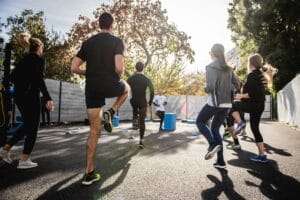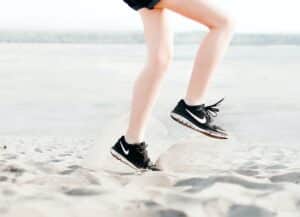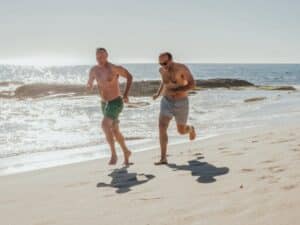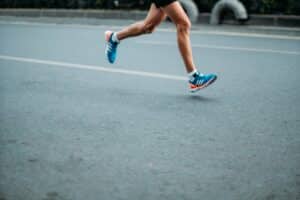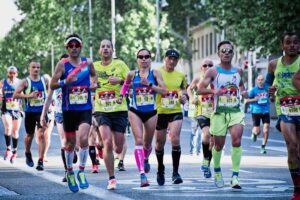Whether it’s the long hours, intense focus, or overwhelming pressure, running can drain the enthusiasm out of anyone.
The best way to run without getting tired is to increase the frequency of your workout. Your body gets conditioned and acclimated to running faster and longer distances when you run regularly. Your body adapts to the activity in the same way it does to learning new skills like playing tennis or riding a bike.
You become faster, stronger, and fitter as you exercise more often. Running is the perfect low-impact aerobic exercise because it has a low impact on your joints and muscles, and it’s a great calorie burner.
It is well documented that the majority of people have difficulty running long distances. What many people don’t realize is that it takes time to learn how to run without getting tired. So make sure to keep reading this step by step guide that will help you increase your stamina for a proper running form.
Causes of Fatigue and Tiredness When Running
Before getting any further, it is essential to know the causes of fatigue and tiredness when running. It is common for runners to feel tired during or after a run, which can be overcome.
But if the tiredness and fatigue persist and affect your health and daily life, you should seek some medical help. While running, the signs of exhaustion are nausea, dizziness, weakness, and shortness of breath. Some runners might feel chills and a headache, have increased heart rate and feel warm and sweaty.
Many factors cause fatigue when running. These include dehydration, low blood sugar, stress, and lack of proper sleep, among others. There are ways to alleviate some of these factors.
Still, if you don’t keep your body adequately hydrated while exercising, you may feel weak, fatigued, and have a hard time performing your best. It’s easy to be dehydrated when you’re exercising because your sweat makes you lose fluid and also because you often drink more than you should while you’re working out.
Lactic Acid Buildup is another cause of tiredness when running or other physical activity. Suppose you’re exercising for too long without giving your body enough time to recover and repair. In that case, lactic acid builds up in your muscles. This is caused by a lack of carbohydrates in your diet and is one of the reasons why running for longer than 30 minutes can make you feel tired.
Tips: How To Run Without Getting Tired

If you have been running for some time, you may have noticed that you tend to become tired after an hour or two. One way to avoid this from happening is to change your routine.
It is always recommended to vary the exercise you perform; don’t stick to the same workout every day. You can also alter your type of training to include some strength exercises and some cardio, or you could follow the below-mentioned tips to avoid getting tired when running.
Stay Well Rested
Sleep deprivation is widespread in adults and is one of the major causes of getting tired when running. Sleep deprivation results in many problems for runners, such as any workout feeling harder than before, glycogen production becoming slower, which helps you run, and increased stress hormones.
The average sleep hours should be from 7 to 8 hours for an adult. To overcome sleep deprivation, try to make a routine of early to bed and early to rise. Your sleep schedule should be consistent every night. Try to avoid such practices before going to bed that is distracting, such as sticking to your smartphone or watching TV. For a good night’s sleep, the environment should be dark, calm, and distraction-free.
Warm Up
A warmup is essentially a brief period of activity after a rest period in which the body is prepared to perform more strenuous activities. Warming up is widely accepted as a form of general physical preparation for sports and exercise; a warmup can include activities such as stretching, dynamic movement drills, or even light jogging.
Whether you are running for fun or training for a marathon, a warmup before any run is critical. It helps increase your heart rate and keep the blood flowing through your muscles, which reduces any risk of injury associated with running and prevents you from getting tired altogether.
A warmup routine should consist of dynamic stretches such as:
- Lower Back Stretches
- Quadriceps
- Hamstring Stretch
- Calf Stretch
- Adductor Stretch
- Hip Flexer Stretch
- Sitting Twist
You can also do some running drills to pump your heart rate, loosen up muscles and prepare for a run. Following are some running drills:
- Butt kicks
- High knees
- A-skips and B-skips
- Carioca drill
- Straight leg bounds
Fuel Your Body and Hydrate Properly
You’ll need lots of fuel to sustain you through your run because running burns calories faster than the body stores them. So if you are not appropriately fueled, you will feel tired shortly within your run, face decreased performance, and have a greater risk of injury.
So it is recommended to have a carbohydrate-rich meal prior to running. Carbohydrates provide glycogen, an essential source for fueling your body during a run.
This doesn’t mean you should go for a large meal, but the food intake should be enough to fuel you through the run. You should also add fruits, vegetables, and lean meat into your diet throughout the weekly menu.
As much as carbs are essential for a run staying hydrated is of similar importance. Our bodies lose significant amounts of fluids during running in the form of sweat.
To replenish the body fluids, you should keep a healthy innate of water and electrolytes to maintain a steady running form. Sports drink also provide runners with right amount of hydration and electrolytes.
Set Your Pace
One of the reasons for getting tired while running is that runners try to run as fast as possible. Instead of outpacing yourself, you should start with a comfortable pace that is neither too fast nor slow. The first mile will start off slow so that your body gets used to the running intensity.
Once you feel comfortable with your pace, try to run a long distance to test your speed, stamina and fitness level.
To run without getting tired, it is recommended to achieve a conversational pace. But if you are a beginner and don’t know how to achieve a target pace, you can use a running pace calculator. A pace calculator will give you the target pace per mile when inputting your pace, time, or distance.
Interval Training
You should adopt an interval training plan to boost your speed, endurance, and stamina without getting tired when running. The interval training for runner includes periods of low and high intensity level exercise and rests in between.
In the book Run Like A Pro Even If You Are Slow, the author Matt Fitzgerald and Ben Rosario break down the interval training into an 80-20 principle. This marathon training plan is perfect for runners of any fitness level to achieve the pro level.
The 80-20 interval training plan includes 80% of low intensity level walking and running for a certain period. Whereas the 20% include the high intensity of fast-paced running or sprinting.
Gradually the intensity levels should be increased to increase the speed, endurance and stamina. Remember to take rests in between to prevent injuries.
Strength Training
If you’re thinking of how to run without getting tired, then make sure to incorporate strength training into your training plan to achieve a proper form.
Where running improves your cardio, your muscles require strength to keep up with long distance running. Strength training targets those muscles that help you propel your body forward: the glutes and quadriceps. You will be able to feel the difference in your endurance by strengthening your muscles.
Some of the best strength training exercises are:
- Squats
- Lunges
- Deadlifts
- Pushups
- Planks
Listen To Your Body
We know that running has a great impact on our bodies physically, from staying fit and healthy to mentally making us calm and relaxed.
But it is a demanding activity that requires a lot of mental and physical stamina, and overtraining can jeopardize your running activities and increase exhaustion level.
You should always listen to your body, slow down, and take a break when you feel tired. If you face some sort of injury, make sure you rest your body to recover it or adopt ways to prevent it.
For example, the best toe caps for running can help prevent blisters and chafe in your feet. Knowing when to stop running can prevent any risk of injury that could cause tiredness when running.
Be a Consistent Runner
Consistency is an important part of running. Being consistent increases your stamina, fitness level, and endurance. Suppose you are not consistent and are a casual runner.
In that case, you might lose your running form and experience fatigue and tiredness when you start running. It can be hard to stay a consistent runner, but a training plan can help schedule your running routine throughout the week.
There are many running routines which you can adapt according to your lifestyle to stay fit and prevent tiredness when running.
Frequently Asked Questions
The most common injury runners face runners’ nipples due to repeated chafing and sweating. Luckily there are runner nipple solutions that can help prevent and cure it.
Runners can put their phones while running in a running belt, hydration belt, pockets, armbands, and women can use sports bras to keep their phones safe.
To become a consistent runner, you should run three to five times a week. Each running session should be at least 30 minutes of low and high intensity running.
Conclusion
Human bodies are incredible in terms of adaptability. By altering your training plans, you can prevent fatigue and tiredness when running. Not only that, but you can increase your speed, stamina and endurance by running consistently.
So whether you are running to stay fit or training for a marathon, now you know how to run without getting tired.



















